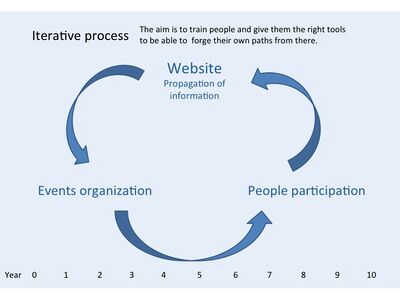LED 2016 Group D Democratic Change Process: Difference between revisions
No edit summary |
|||
| Line 14: | Line 14: | ||
<gallery caption="Change Process" widths="600px" heights="300px" perrow="1"> | <gallery caption="Change Process" widths="600px" heights="300px" perrow="1"> | ||
File:Slide1.jpg|Change Process: Raising awareness of the benefits of the website on village life will be an ongoing process over many years. Attendance at various markets and village events will help to keep the website in the forefront of people's minds. The workshop will help to develop the website to bring the maximum benefit to the community and ensure their input and needs are properly incorporated. | File:Slide1.jpg|Change Process: Raising awareness of the benefits of the website on village life will be an ongoing process over many years. Attendance at various markets and village events will help to keep the website in the forefront of people's minds. The workshop will help to develop the website to bring the maximum benefit to the community and ensure their input and needs are properly incorporated. | ||
File:Group D-Slide06.jpg| Long-term change process: It is envisaged that there is an iterative cycle of awareness raising followed by workshops to ensure that the website remains connected to the communities needs. These workshops would have to be continued in a fun, interesting and creative way to maintain enthusiasm and to attract new people to participate. | |||
</gallery> | </gallery> | ||
Revision as of 07:45, 19 June 2016
The process of planning can be very complex and can also include a high probability of failures. In any case, planners should, to prevent a breakdown, find a democratic way of designing. Planning should also include the value of local knowledge. This inclusion improves the legitimacy of the process. In any case, forward looking planning increases the chance of obtaining a successful, consensus result. Another important aspect that any planner should be aware of is that good policy making can be very influential. Therefore the art of planning processes lies in finding effective ways for stakeholders to participate. Participation and experience in the landscape planning process can be helpful for learning as is the inclusion of stakeholder contributions to the analytical framework and results
Power Map
- Power Map
Power Map: Tourism will affect many aspects of village life and hence there are many stakeholders. These stakeholders, however, will have varying interests in tourism and different degrees of impact on it. Some stakeholders will need to be included early on to counteract any negative input at a later stage, thus an awareness of the power dynamics within the village is vitally important.
Change Process
- Change Process
Change Process: Raising awareness of the benefits of the website on village life will be an ongoing process over many years. Attendance at various markets and village events will help to keep the website in the forefront of people's minds. The workshop will help to develop the website to bring the maximum benefit to the community and ensure their input and needs are properly incorporated.
Long-term change process: It is envisaged that there is an iterative cycle of awareness raising followed by workshops to ensure that the website remains connected to the communities needs. These workshops would have to be continued in a fun, interesting and creative way to maintain enthusiasm and to attract new people to participate.
Concluding reflections
- Reflect on your case and your change model. Potentials? Limitations?
- Which practices or practitioners have framed your work, including a brief narrative of the potential gaps you have filled in our knowledge as designers and planners of participation.(approx. 150 words)


